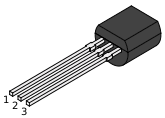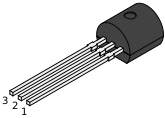TO-92
The TO-92 is a widely used style of semiconductor package mainly used for transistors. The case is often made of epoxy or plastic, and offers compact size at a very low cost.
History and origin
The JEDEC TO-92 descriptor is derived from the original full name for the package: Transistor Outline Package, Case Style 92.[1] The package is also known by the designations SOT54 and JEITA SC-43A.[2] By 1966 the package was being used by Motorola for their 2N3904 devices among others. [3]
Construction and orientation
The case is molded around the transistor elements in two parts; the face is flat, usually bearing a machine-printed part number (some early examples had the part number printed on the top surface instead). The back is semi-circularly-shaped. A line of moulding flash from the injection-moulding process can be seen around the case.
The leads protrude from the bottom of the case. When looking at the face of the transistor, the leads are commonly configured from left-to-right as the emitter, base, and collector for 2N series (JEDEC) transistors, however, other configurations are possible, such as emitter, collector, and base commonly used for 2S series (Japanese) transistors or collector, base, and emitter for many of the BC series (Pro Electron) types.
If the face has a part name made up of only one letter and a few numbers, it can be either a Japanese or a Pro Electron part number. Thus, "C1234" would likely be a 2SC1234 device, but "C547" is usually short for "BC547".
The leads coming out of the case are spaced 0.05" (1.27 mm) apart. It is often convenient to bend them outward to a 0.10" (2.54 mm) spacing to make more room for wiring.[4] Units with their leads pre-bent may be ordered to fit specific board layouts, depending on the application. Otherwise, the leads may be bent manually; however, care must be taken as they can break easily, as with any other device that is manually configured.
The physical dimensions of the TO-92 housing may vary sightly depending of the manufacturer, however, the 1.27mm lead spacing must be respected.
Advantages
- Transistors of this type can be made very inexpensively and take up very little board space. Most models are readily available in large quantities from wholesale distributors.
- They are easy to find in small electronics stores because of their wide usefulness, making them a popular choice for hobby work and prototyping.
Disadvantages
The main disadvantage of this style of case is the lack of heat sinking.
- Transistors and ICs of these types cannot handle as much power as higher-power equivalents, such as the TO-220 and can burn out quickly if they dissipate excessive power.
- There is no standard pinout for the TO-92. The American BJTs use the E-B-C pinout while their Japanese counterparts use the E-C-B pinout and some RF devices use the B-E-C pinout.
Voltage and current
Although TO-92 devices are mainly used in low-voltage / low-current (<30 V; <1 A) applications, high-voltage (600 Volt Vce) and high-current (5 A Ic) devices are available. Nominal maximum power dissipation is less than one watt (600 mW).
Common transistors using a TO-92 case
Additional uses of the TO-92 case
- MK484, AM radio IC
- 78Lxx series voltage regulators
- TCR1AM, Triac
- DS2501-UNW/DS2502, Add-only memory
- DS18B20, Temperature sensor, digital output (1-Wire)
- LM335, Temperature sensor, analog output (+ 10-mV/°K)
- OH090U, Hall effect sensor[5]
See also
References
- "JEDEC TO-92 package specification" (PDF). JEDEC. Archived from the original (PDF) on June 18, 2017.
- "TO-92 (SOT54)". Nexperia. 2004-11-16. Retrieved 2017-12-12.
- Motorola 1966 Semiconductor Handbook|https://archive.org/stream/bitsavers_motoroladaSemiconductorHandbook2edAug66_80459525/1966_Motorola_Semiconductor_Handbook_2ed_Aug66_djvu.txt
- Bourns. "Package Mechanical Information, TO-92" (PDF). Retrieved 28 February 2016.
- http://www.digikey.com/product-detail/en/OH090U/365-1001-ND/374779
External links
| Wikimedia Commons has media related to TO-92 transistor packages. |
- TO-92 Package, EESemi.com
- Essay about TO92 housings (German) by Dipl.-Ing. Bernd Wiebus at German national library server.

